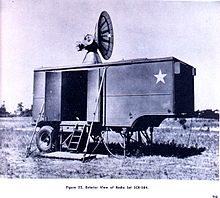 Exterior view. All operational equipment was housed inside, although the M-9 director, and electrical generators were separate. The antenna retracts into the van for travel. | |
| Country of origin | US |
|---|---|
| Designer | MIT Radiation Laboratory |
| Frequency | Four bands around 3,000 MHz |
| PRF | 1707 pulses per second |
| Pulsewidth | 0.8 microsecond |
| Range | 70,000 yd (40 mi; 64 km) |
| Diameter | 6 ft (1.8 m) |
| Azimuth | 360 degrees |
| Elevation | -175 mils (-9.8 degrees) to +1,580 mils (+88.9 degrees) |
| Precision | Range error: 25 yards; azimuth error: 1 mil (0.06 degree); elevation accuracy: 1 mil (0.06 degree) |
| Power | 250 kW |
| Related | Data from U.S. War Department Technical Manuals TM11-1324 and TM11-1524 (published April 1946 by the United States Government Printing Office) |
The SCR-584 (short for Set, Complete, Radio # 584) was an automatic-tracking microwave radar developed by the MIT Radiation Laboratory during World War II. It was one of the most advanced ground-based radars of its era, and became one of the primary gun laying radars used worldwide well into the 1950s. A trailer-mounted mobile version was the SCR-784.
In 1937, America's first fire-control radar, the SCR-268 radar, had proven to be insufficiently accurate due in part to its long wavelength. In 1940, Vannevar Bush, heading the National Defense Research Committee, established the "Microwave Committee" (section D-1) and the "Fire Control" division (D-2) to develop a more advanced radar anti-aircraft system in time to assist the British air-defense effort. In September of that year, a British delegation, the Tizard Mission, revealed to US and Canadian researchers that they had developed a magnetron oscillator operating at the top end of the UHF band (10 cm wavelength/3 GHz), allowing greatly increased accuracy. Bush organized the Radiation Laboratory (Rad Lab) at the MIT to develop applications using it. This included a new short-range air-defense radar.
Alfred Lee Loomis, running the Rad Lab, advocated the development of an entirely automatic tracking system controlled by servomechanisms.[1] This greatly eased the task of tracking targets and reduced the manpower needed to do it. They were also able to take advantage of a newly developed microwave switch that allowed them to use a single antenna for broadcast and reception, greatly simplifying the mechanical layout. The resulting design fit into a single trailer, could provide all-sky search and single target tracking, and followed the targets automatically. In close contact with the Rad Lab, Bell Telephone Laboratories was developing an electronic analog gun-director that would be used in conjunction with the radar and servo-actuated 90 mm anti-aircraft guns.
The radar was intended to be introduced in late 1943, but delays meant the SCR-584 did not reach field units until early 1944. They began replacing the earlier and more complex SCR-268 as the US Army's primary anti-aircraft gun laying system as quickly as they could be produced. They proved easier to use in the field than the less advanced Canadian/British GL Mk. III radar, and many SCR-584s were rushed to England where they were an important part of the defences developed to counter the V1 flying bomb. By the end of the war they had been used to track artillery shells in flight, detect vehicles, and reduce the manpower needed to guide anti-aircraft guns.
- ^ Bennett, S., A history of control engineering: 1930-1955, Peregrinus,1993